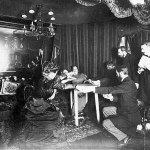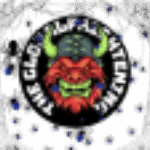Said to haunt several houses around Kleinbasel district in Basel, Switzerland, the terrifying ghost known as The Gray One was roaming the street. Especially in a now demolished house on Claraplatz, two little girls had to endure his persistent haunting.
At the main square of Kleinbasel, today’s bustling Claraplatz hums with the familiar rhythm of city life. The Clara Quarter is Basel’s smallest district. It is named after the Clara Church and the Claraplatz in front of it, which were part of the former St. Clara Convent.Shoppers, commuters, and café patrons pass by without giving a second thought to what once stood on this very ground that is the long-forgotten Abbess’ Court (Äbtissinnenhof), a stately residence rich in history and mystery, whose stones held secrets and whose shadows moved with a life of their own.
Read More: Check out all ghost stories from Switzerland
Long before it was demolished in 1951, the Abbess’ Court was known for the unsettling presence said to linger within its walls. The house had a ghost, one so persistent and distinct that it earned a name whispered in townhouses and taverns alike: “Der Graue”, The Gray One.


A Spirit in Franconian Garb
The most documented hauntings occurred during the 19th century, when the Schetty family took residence within the halls of the Abbess’ Court. The fire engine commander, Joseph Schetty from a wealthy silk-dyer family, moved into the house with his family. And not long after, the Gray One appeared.
The ghost appeared as a somber figure dressed in traditional Franconian costume with a tricorn hat. His most unsettling feature was the braided wig he wore upon his head, a strange, almost theatrical accessory that made his silent materializations all the more unnerving. His elegant buckled shoes moved ghostly around the house, rattling with chains, his voice only miserable moans echoing through the house and the surrounding neighborhood.
It’s not certain of who this ghost of a man used to be. However, apparently, this house spirit had its roots in the time when Samuel Werenfels gave the Abbess’s Court its baroque appearance in 1748. It also seems that the haunting started way before the Schetty family moved into the house as well.
The Gray One was a creature of habit and, it seems, of unsettling intent. His favorite haunt was the bedroom of the two young Schetty daughters, where he would appear without warning, standing silently in the dim light, a spectral observer from another age.
When he appeared to them in their room, staring at them from the corners, the younger sister would try to hide under the covers, as the oldest screamed pious refrains at the ghost, seemingly offending the ghost who would vanish into thin air when he heard it.
It seemed that the fear he held over the girls slowly subsided. One evening, one of the daughters was sitting in the living room sewing, when a hand was suddenly laid on her shoulder and she said in a stern voice: “Who’s that messing around behind me?”
She knew well that it was the Grey Man. But her fear had turned to anger, and she simply stared at him. This made him disappear, at least for a while.
Rumbles in the Attic from the Gray One
When foul moods overtook him, whether stirred by the behavior of the living or by some ancient grievance now lost to time, The Gray One would retreat to the attic of the house. There, in the dead of night, he made his displeasure known by loud, relentless rumbling that echoed through the house, keeping the Schetty family awake with its strange, otherworldly clatter of chains or moving the furniture around.


These disturbances became so notorious that even Basel’s typically skeptical townsfolk began to murmur about the restless house spirit on Claraplatz.In the end it was decided that they needed to do something to keep him away. According to the legend, they decided to paint a pentagram on the threshold of the house. But did this truly keep him away?
A Legacy of Hauntings
The legend took an even stranger turn after the death of Joseph Schetty, the patriarch of the household that tried to banish the haunting of his daughters when he was alive. It was said that he, too, became bound to the ancient residence after death.
According to one enduring tale, a cleaning maid worked in the house some years later after his death. She claimed to have seen Joseph’s ghost seated solemnly in his old study. The room was empty, and yet there he sat as an unquiet shade amid the flickering lamplight.


She continued cleaning the room, not bothering about his ghost, perhaps thinking it was just a visitor in the study. But when she tried to pull the fur out from under his feet to brush it, he threw it at her with an angry look. Evidently, he wanted to be left alone.
The Spirits Beneath Claraplatz


Though the Abbess’ Court was demolished in 1951, the legends did not entirely vanish with its stones. Locals claimed that, for years after the building’s demise, strange phenomena continued to occur in the vicinity: phantom footsteps, inexplicable knocking, and fleeting glimpses of a gray figure moving in reflections or corner shadows, particularly near the old foundations.


Today, Claraplatz bears little resemblance to its ghostly past as the haunted house was demolished and replaced by a modern residential and commercial building. Modern shops and trams now cover the old ground. But for those attuned to such things, the sense of something lingering, a presence beyond reason and time, occasionally seems to cling to the night air.
Newest Posts
-

The Gray Ghost of Claraplatz: Kleinbasel’s Neighborhood Spirit
Said to haunt several houses around Kleinbasel district in Basel, Switzerland, the terrifying ghost known as The Gray One was roaming the street. Especially in a now demolished house on Claraplatz, two little girls had to endure his persistent haunting.
-

Ghosts of Uetliberg Hill and The Three Beeches by the Manegg Castle Ruins
A woman scorned by the Manesse family from the ruins of the old Manegg Castle on the hills of Uetliberg in Zurich, she is said to haunt the place she was seduced and ended her life, appearing to passersby on stormy nights.
-

The Restless Spirits of Kleines Klingental: Basel’s Haunted Nunnery
A house of God turned into the sinful playground of the rich and powerful nuns, the former Dominican Cloister, Kleines Klingental in Basel is said to be haunted by the ghostly nuns, still to this day praying to be released from their sins.
-

Anchanchu: The Shapeshifting Vampire of Bolivia’s Lonely Roads
In the loneliest corner of the Andean highlands of Bolivia and Peru, an Aymaran legend of the Anchanchu or the Abchanchu is said to lurk. Disguised as an elderly man, weary from his travels, he uses people’s goodness to attack and drink their blood.
-

The Legend of the Jiāngshī: China’s Hopping Vampire
With stiff limbs after rigor mortis has set in, the Chinese vampire entity, the Jiāngshī is after the life force of the living. But where did the lore of the hopping undead really come from?
-

The Knocking Ghost of Utengasse 47: Basel’s Poltergeist Case
In a small apartment at Utengasse 47 in Basel, a poltergeist was said to torment the family living there. It got so bad and they found no solution that the family had to vacate the place instead.
-

Spiritism and the Religion of Spirit Communication
Spiritism or Kardecism is a philosophy and religion of spirit communication. After being inspired by the Spiritualist movement, the French Allan Kardec developed the loose movement of seances, mediums and communicating with the dead into something people still practice today.
-

Spiritualism and the Occult: Automatic Writing and When Ghosts Slide Into Your DMs
In the height of the spiritualism movement of séances, mediums and table turning, automatic writing was a popular way to communicate with the dead. But what type of writing and messages did the practice leave us with?
-

Table Turning: When Spirits Spill the Tea Through Furniture
One of the earliest ways of communicating with the dead in the modern era was through Table Turning or Table Tipping. For many it was nothing more than a fun parlor trick and game, but for others it became a lifestyle and the foundation of a new spiritual movement.
-

The Dark Origins of the Ouija Board: A Mysterious History of Spirit Communication
The Ouija Board has a long and winded history that has created its own lore and rules. What is really the truth behind the board, where spiritualism meets consumerism?
-

The Ouija Board Murder in Buffalo
Many horrible things have been blamed on the Ouija Board over the years. One of the most famous cases was the murder often named The Ouija Board Murder in Buffalo were a woman in Buffalo was killed after the Ouija Board pointed her out in a mission for revenge.
-

The Spiritualist Movement: The Fox Sisters Who Started a Ghostly Revolution as a Prank
It’s impossible talking about communicating with the dead without talking about The Fox Sisters and their impact they had on the Spiritualism movement as well the enduring popularity ghosts and the afterlife have on people, even when its well known fraudsters performing.
References:
Happy Halloween! 🎃 Ein Streifzug durch Basels grusligste Orte — Bajour
Spuk und Geister im alten Basel
Äbtischer Hof am Claraplatz – Basel




